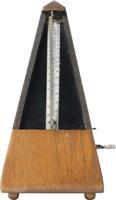 The modern metronome is an indispensable practice tool for musicians of any level of experience. Most student musicians and even some more experienced musicians do not realize how inconsistent humans are in terms of their perception of time. Our perception of time changes from moment to moment based on our emotional state. Music played at louder dynamics tends to rush, softer music tends to drag. Even a difference in age of the performers tends to produce differences in perceptions of "how fast time passes."
The modern metronome is an indispensable practice tool for musicians of any level of experience. Most student musicians and even some more experienced musicians do not realize how inconsistent humans are in terms of their perception of time. Our perception of time changes from moment to moment based on our emotional state. Music played at louder dynamics tends to rush, softer music tends to drag. Even a difference in age of the performers tends to produce differences in perceptions of "how fast time passes."Digital metronomes are readily available from any music retailer, as an app for your iPhone, or many other online metronome web sites.
The Benefits of Playing With A Metronome
Most student musicians have an unpleasant experience when they first have a metronome forced on them by a teacher. Suddenly, music that the student thought they played well becomes clumsy and hesitant. This is because as they practiced before, they fluctuated in tempo based on their ability to correctly perform each passage. Parts that were "easy" to their perception tended to rush, while passages that were "hard" to them tended to drag. By playing with a metronome, the student is forced to perform at a consistent tempo, which will immediately highlight the passages in the music that they can not perform technically.
Students are reluctant to use a metronome because it "is frustrating" or "makes everything harder". This perception is due to the fact that they can "play it better" when they are allowed to make their own fluctuations in tempo than they can when they are required to maintain pulse. Once students work with a metronome for some time, under the guidance of a teacher, they begin to understand how valuable it can be. Here are some tips for incorporating metronome work into the practice of a student who does not use one.
Ten Tips For Incorporating Metronome Work Into A Practice Routine
Most student musicians have an unpleasant experience when they first have a metronome forced on them by a teacher. Suddenly, music that the student thought they played well becomes clumsy and hesitant. This is because as they practiced before, they fluctuated in tempo based on their ability to correctly perform each passage. Parts that were "easy" to their perception tended to rush, while passages that were "hard" to them tended to drag. By playing with a metronome, the student is forced to perform at a consistent tempo, which will immediately highlight the passages in the music that they can not perform technically.
Students are reluctant to use a metronome because it "is frustrating" or "makes everything harder". This perception is due to the fact that they can "play it better" when they are allowed to make their own fluctuations in tempo than they can when they are required to maintain pulse. Once students work with a metronome for some time, under the guidance of a teacher, they begin to understand how valuable it can be. Here are some tips for incorporating metronome work into the practice of a student who does not use one.
Ten Tips For Incorporating Metronome Work Into A Practice Routine
- Explain how metronomes measure tempo in "beats per minute." Link those tempo ranges to musical terms they find in their music, such as Adagio and Allegro.
- Have a student play a line of music they have already mastered along with the metronome set to various tempi. Have them focus their attention on aligning their performance with the metronome's pulse.
- Teach students how to use a metronome at slower tempi - either subdividing the metronome's pulse mentally, or setting the metronome to the tempo of the subdivision.
- Teach students how to incorporate the metronome into their practice, which occurs after the initial note learning is accomplished. The metronome becomes useful once they can basically play through a line of fingerings.
- Teach students how to use the metronome to identify technical problem spots in the music and isolate them.
- Give students metronome goals to shoot for - start with a tempo they can achieve comfortably and increase it throughout the period of concert preparation.
- Use the metronome to test students' ability to internalize pulse. Give them a tempo from the metronome, have them count silently in their mind, turn off the metronome as they continue to count internally, have them show their pulse visually with conducting or verbally with counting. Check their results against the metronome.
- Have student improvise duple and triple rhythms while a metronome is playing.
- Teach students how to find 60 and 120 beats per minute without the use of a metronome.
- Have a "speed contest" between students using a metronome. Award a prize to the student who can play a difficult passage the fastest with the greatest accuracy.
One last thought on metronome use: It is possible to overuse the metronome, especially with ensembles. Performers should use the metronome to help develop their own internal or ensemble sense of pulse. It can just as easily become a crutch as having the music teacher clap and count along.